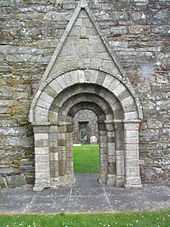Killeshin
| Killeshin | |
|---|---|
| Town | |
 Killeshin Location in Ireland | |
| Coordinates: 52°51′03″N 6°59′52″W / 52.850712°N 6.997805°WCoordinates: 52°51′03″N 6°59′52″W / 52.850712°N 6.997805°W | |
| Country | Ireland |
| Province | Leinster |
| County | County Laois |
Killeshin (Irish: Cill Uisean, meaning "church of Uisean") is a village in County Laois, Ireland on the R430 regional road. Killeshin is a small rural community situated five kilometres west of Carlow town and overlooks the picturesque Barrow Valley. The church at the foot of the Killeshin hills is the site of an early Christian monastery.[1]
Name
Killeshin[2] derives its name from one of the abbots of its famous monastery - Uisin, meaning the Cell or church of Uisin.
History

Killeshin was an important centre for learning and culture as early as the 6th or 7th century when a monastery was founded there by either St. Comgan or St. Diarmait.[3][4][5][6]
"The Martyrology of Oengus the Culdee" states:
February 27 Feast of Comgan...Comgan son of Diarmait...[7]
July 8 Feast of Diarmait...Modimoc...Glenn Uissen...[8]
Index of persons - Comgan, son of Diarmait, feb 27, of Glenn Uissen...[9]
Killeshin or Gleann Uissen,[1] was early known as a great scriptorium. In the Annals of the Four Masters the stratum of Leinster material of the 9th–11th centuries may have been originated at Killeshin. While some four kilometres north west lie the ruins of Sleaty – Sleibthe,[10][11] home to reputedly the first bishop of Leinster – St.Fiacc (c418-498)[1]
Hiberno-Romanesque architecture
Killeshin church is located off the main Carlow-Castlecomer road, adjacent to Killeshin village itself. The church at Killeshin is largely from the 12th century, although some parts show evidence of later rebuilding, including a late Gothic east window The ancient monastery was destroyed in the 11th century and all that remains is a beautifully carved 12th-century doorway: one of the finest examples of hiberno-Romanesque architecture in Ireland.
No trace remains of the 105 ft round tower believed to have once been the tallest in Ireland which stood next to the monastery, it was demolished by an 18th-century landowner who was afraid that the tower could collapse and injure his cattle.[12][13] It is said that ten counties can be seen from the hill above Killeshin.
Public transport
The village is served by the Buggy Coaches Castlecomer-Crettyard-Carlow bus route with one journey into Carlow in the morning and one back in the afternoon.[14] On Saturdays there are two journeys each way. The nearest rail services may be accessed at Carlow railway station approximately 6 kilometres distant.
Killeshin has good fishing spots, in Ballyhide the River Barrow is nearby.
Sport
- Killeshin GAA is the local Gaelic Athletic Association club.
- Killeshin[15] a racehorse named after the village competed in the Grand National steeplechase twice in the 1990s, finishing a remounted sixth in the 1998 Grand National.
See also
References
- ↑ 1.0 1.1 1.2 James Henthorn Todd (1869). Leabhar Imuinn: The Book of Hymns of the Ancient Church of Ireland. Irish archaeological and Celtic society. pp. 291–.
- ↑ Samuel Lewis (1840). A topographical dictionary of Ireland: comprising the several counties, cities, boroughs corporate, market, and post towns, parishes and villages ... : With an appendix describing the electoral boundaries of the several bouroughs as defined by the act of the 2d. and 3d. of William IV. Lewis. pp. 143–.
- ↑ John Lanigan (1822). An Ecclesiastical History of Ireland: From the First Introduction of Christianity among the Irish to the Beginning of the Thirteenth Century. Graisberry. pp. 88–.
- ↑ Saint Adamnan (1857). The Life of St. Columba, Founder of Hy. Printed at the University Press for the Irish Archaeological and Celtic Society. pp. 70–.
- ↑ Wendy Davies; Paul Fouracre (23 April 1992). The Settlement of Disputes in Early Medieval Europe. Cambridge University Press. pp. 171–. ISBN 978-0-521-42895-8.
- ↑ Christian Inscriptions in the Irish Language. Royal Historical and Archaeological Assoc. of Ireland. 1872. pp. 19–.
- ↑ http://reftag.appspot.com/?book_url=http%3A%2F%2Farchive.org%2Fstream%2Fmartyrologyofoen29oenguoft%23page%2F78%2Fmode%2F2up
- ↑ https://archive.org/stream/martyrologyofoen29oenguoft#page/168/mode/2up
- ↑ https://archive.org/stream/martyrologyofoen29oenguoft#page/410/mode/2up
- ↑ Elva Johnston (15 August 2013). Literacy and Identity in Early Medieval Ireland. Boydell Press. pp. 56–. ISBN 978-1-84383-855-5.
- ↑ Various. The Most Ancient Lives of Saint Patrick. Library of Alexandria. pp. 110–. ISBN 978-1-61310-864-2. Retrieved 13 December 2012.
- ↑ Kilkenny and South-East of Ireland Archaeological Society (1864). The Journal of the Kilkenny and South-East of Ireland Archaeological Society. pp. 303–.
- ↑ Joseph Kennedy; Seosamh Ó Cinnéide (1 January 2003). The Monastic Heritage & Folklore of County Laois. Lisheen Publications. ISBN 978-0-9542331-5-0.
- ↑ http://www.journeyplanner.transportforireland.ie/nta/TTB/EFA03__00006299_TP.pdf
- ↑ Stan Hey (31 May 2012). An Arm And Four Legs: A Journey into Racehorse Ownership. Random House. pp. 22–. ISBN 978-1-4481-3923-1.